|
 This page HOUSES
a 14-page report produced in 1916 by US Marine Corps
Intelligence Officer First Lt. Ross E.
Rowell synopsizing the most salient
characteristics of the Conservative-controlled
Nicaraguan military during the years of the
"first" US occupation (1912-1925).
Commissioned by the War College Division of the
War Department, the report
is accompanied here by a series of maps that
graphically illustrate the information it
presents.
This page HOUSES
a 14-page report produced in 1916 by US Marine Corps
Intelligence Officer First Lt. Ross E.
Rowell synopsizing the most salient
characteristics of the Conservative-controlled
Nicaraguan military during the years of the
"first" US occupation (1912-1925).
Commissioned by the War College Division of the
War Department, the report
is accompanied here by a series of maps that
graphically illustrate the information it
presents.
Click
HERE or on the image at right to
access the PDF file of the report (9.7
MB; the original report is housed in Record
Group 127, Entry 38, box 26).
One of the things this report makes clear
is the extent to which politics & patronage
infused the Nicaraguan military at every level.
As commander of the nation's armed forces, the
president appointed every officer in the
military. Presidential political
appointees such as jefes políticos
(departmental governors) also served as military
leaders (comandantes de armas) in their
zones of jurisdiction. Jefes
políticos, in turn, appointed their
underlings to serve as mayores de la plaza
(municipal chiefs of police) and local judges (jueces
de mesta and jueces de cantón).
Not included in Rowell's report was another
layer of authority emanating from the
Ministerio de Hacienda (Ministry of the
Treasury), which had its own groups of armed men
charged with collecting local taxes and
preventing smuggling & contraband (such as
illegal grain-alcohol distilleries, known
colloquially as cususas). At the
local level the exact lines of authority were
cross-cutting and opaque, and depended on the
precise configurations of political power in
specific instances.
Compare the 1916 troop distribution graphic
to the 1929 military organization under the
Guardia Nacional. Under the Guardia's new structure
of authority, after 1929 military "areas" were
wrenched apart from the political jurisdictions
to which they had corresponded in the century
since independence from Spain in 1821.
After 1929, the nation's military was no longer
under the under the direct authority of the
president of the republic, but instead of the
Jefe Director of the Guardia Nacional. The
latter, at least constitutionally & in theory,
was under the authority of the president (much
like the chairman of the Joint Chiefs of Staff
serves under the authority of the US president)
— but in practice the structure allowed for the
Guardia's Jefe Director to control & wield a
base of power wholly separate from the
president's. Predictably, this
reorganization created conditions ripe for a
coup d'etat by the chief of the Guardia — which
is exactly what happened in 1936, when Jefe
Director Anastasio Somoza García ousted
President Juan B. Sacasa, engineered the
presidential elections in his own favor &
essentially made himself constitutional
dictator.
What this report shows, in short, is
that before the creation of the Guardia in 1927,
military power in Nicaragua was radically
dispersed and decentered, with the military
capacities of the central state mediated through
local & regional powerholders and based, at
bottom, on hierarchical but reciprocal relations
of political patronage & clientage. It
shows what the Guardia, as a "non-partisan"
national army, was intended by its architects to
transcend.
|

